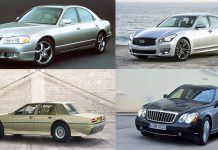18 Motorcycle Mods Police Don’t Like
Motorcycle riders come in all shapes and sizes. Whether they’re outlaws on stripped-down Harleys, rebellious teens on customized Bosozoku bikes or hipsters riding mopeds, they’re all unified in one thing: wanting to make their motorcycles and scooters their own. One way to do that is through modifications.
A biker feels that a motorcycle is their own personal property to do whatever they want with it. They feel like the law is infringing on those rights. Despite having a cavalier persona, bikers are going to take advantage of those mods that are either vaguely illegal or lazily enforced.
In an ideal world, motorcyclists are technically supposed to report any and all mods they perform to insurance companies. It makes us wonder how many bikers really go through such etiquette? While not all mods listed are necessarily dangerous to perform, we add this obligatory warning: don’t try these at home.
18 USING AFTERMARKET INDICATORS
 Many riders look at the law as a thing that prevents modifications, even though it exists to protect them. There are parameters in place about some of the smallest aspects of a bike, including its indicators.
Many riders look at the law as a thing that prevents modifications, even though it exists to protect them. There are parameters in place about some of the smallest aspects of a bike, including its indicators.
Granted, there are a lot more style options on the aftermarket, but not all of them are quality products. A motorcycle tuner can often get swept up in wanting to make their bike look cool while forgetting about safety.
17 AESTHETIC LIGHTING

There are few motorcycle mods as eye-catching as lighting. That’s why the law takes issue with certain LED lights in the first place. According to Jalopnik, they’re distracting and can potentially affect other people’s driving on the road, especially brighter ones. Although the laws vary from state to state, they tend to place some limitations as far as color and placement go. That leaves the chassis off limits. Still, some riders like to push the envelope by lighting up their chassis with colorful LED lights that will certainly get attention, but not always a reprimand.
16 ADDING HORNS

Horns aren’t looked upon too fondly. They make a lot of noise and are liable to scare lots of people. They’re also not the smartest mod to have. Horns are capable of reaching over 100 decibels.
That makes these targets for the law. The thing is, even though horns are really loud, it’s not always easy for cops to track down the instigator.
15 REMOVING MIRRORS

All motorists need mirrors. It’s necessary for changing lanes and adding visibility to what’s behind and around a rider. Regardless of how essential mirrors are, some riders like to live on the edge by removing them entirely. This is definitely not allowed on the road. According to Axle Addict, there are smaller alternatives like CRG Hindsights that look like small circles hanging off the edge of handlebars. Despite other options, some are willing to take them off and ride without mirrors.
14 CONCEALING TURN SIGNALS

In stating the obvious, turn signals are essential to other drivers, riders and pedestrians on the road. There’s a mod, however, that makes turn signals harder to see. Some riders prefer their bikes have a “cleaner” aesthetic look.
Now, some are hiding their turn signals, making it that much more difficult to forecast. Some builds place the turn signals under the back seat or even the clutch. It’s subtle enough that many will get away with it.
13 REMOVING THE FRONT BRAKES

Regular maintenance on a motorcycle involves removing the front brake pads and putting on new ones. The website Vehicle Maintenance Wonder How To details the process, which entails finding a socket wrench, taking off the bolts, the caliper, and then the pads themselves. Then, one merely reverses the order of steps and puts new brake pads in place. Some riders, however, are going to greater—and riskier—lengths. They remove the front brakes entirely. Many riders think the back brake is sufficient enough to bring the bike to a complete halt.
12 RESHAPING FENDER EDGES

Modifying a bike requires that a tuner remove pieces and parts. They have the choice of either replacing them or leaving a more minimalist, cleaner aesthetic. Bobber styled motorcycles will often bear trimmed down fenders.
Tuners often find that the fender is too bulky. Reshaping fenders leads to an appealing look and style that’s unique. Even though the law doesn’t like it, riders won’t often get in trouble for it.
11 CHASSIS CHANGES AND BIGGER ENGINES

On the surface, there isn’t a problem with reshaping a motorcycle chassis; it all just depends on the tuner’s intent. If they’re molding a chassis to make way for a larger displacement engine, then that could affect their license. According to Ultimate Motorcycling, 14 states have a unique licensing system that’s determined by an engine’s displacement. Therefore, any modification that ushers in a higher displacement engine that conflicts with their license’s parameters they choose to ride could turn out to be an issue with law enforcement.
10 TAMPERING WITH EPA LIMITATIONS

When someone buys a motorcycle from a major brand, it’s supposed to adhere to strict emission standards. If that rider decides to modify their bike’s muffler, they’re then accountable for meeting strict emission law.
That makes parts of the motorcycle like tailpipes, exhaust systems, fuel tanks and lines sensitive areas for modification. On the surface though, it’s hard for law enforcement to pick up on any changes made to these parts.
9 REMOVING REFLECTORS

The law has something to say about nearly every aspect of a motorcycle, including reflectors. Many states require reflectors on both the front and rear, as AAA Driving Laws states. Some motorists don’t hesitate to disobey these rules though. They’ll add more or even remove them completely. It’s an easy mod that doesn’t take much to perform. Unfortunately, this mod only puts the rider in harm’s way. To riders, a reflector looks bad, even though it protects them from others at night.
8 AIMING HEADLIGHTS UP

The law is plain and simple when it comes to lights, but vague in the area of placement. That leaves room for tuners to adjust motorcycle headlights the way they see fit.
According to The Bellingham Herald, there are rules about how high lights have to stand off the ground and they can’t shine directly at others’ eye levels. Some motorcycle tuners like to adjust the headlights to shine higher though if it makes others aware of their presence.
7 ENGINE ADJUSTMENTS

The Man doesn’t like it when riders modify their motorcycles. There’s a myriad of changes one can make to the engine, whether it’s to the displacement itself or its cylinders. These are both methods tuners use to get more power out of their motorcycles. They’re also the kind of mods that are hard to catch. As Cartoq reports, engine mods aren’t as visible on the surface and will be harder for cops to pick up on. As much as law enforcement wants tuners to kick the habit of getting as much power out of their motorcycles, mods like this aren’t visible on the surface.
6 REMOVING MUFFLERS

Motorcycle riders have an infamous reputation for making their engines sound like banshees. Despite laws in place about loud engines, why do riders keep committing the same offense?
Once the ticket is cleared, however, they turn back around and mod out the exhaust exactly to the configuration they had it at when the cop pulled them over. It’s a vicious cycle.
5 ADDING NITROUS OXIDE

Also called Laughing Gas, nitrous oxide can easily soup up a motorcycle to make it run more powerfully. It’s not exactly the safest mod around, but that doesn’t stop tuners from adding it. Although the law doesn’t state anything specific about nitrous oxide, it does make an engine more powerful, while potentially breaking some emission laws all at the same time. According to Riderz Law, the noise and pollution of a motorcycle could infringe on EPA laws, thus making nitrous oxide kits problematic when added to bikes.
4 FLASHING HEADLIGHTS

Many riders embody the traits of a rebel. Some of them don’t care if you think their motors sound loud. Cycle World reports that many riders mod their bikes out with high-intensity lighting.
Some headlights can flash repeatedly, giving off a strobe effect, which riders use to impel other cars to speed up, change lanes or yield. The law doesn’t look favorably on this mod when it’s used improperly.
3 ADDING WHEELS

Many of the law books out there specifically refer to “two-wheel vehicles,” as DMV’s website details in several guidelines and rules. They write it out clearly who they’re referring to. When tuners add another wheel as a way to circumvent the law, they’re playing a risky game. These days though, it isn’t rare to find three-wheelers roaming the streets that come from major brands. Tuners might be breaking a few laws with their customized three-wheelers, depending on what they added and removed.
2 COLORFUL HEADLIGHTS

Similar to the flashing headlights, motorcyclists have limitations as far as what color they can use for lighting. In a breakdown of laws according to each state, Illumimoto notes that only some colors are acceptable.
For example, Arkansas allows more colors than other states, including red, blue and green, but specifies they must be in front. Looking at another state for comparison, Colorado doesn’t allow blue or red lights. While some cops are going to crack down on the color of lights, most probably won’t even consider it.
1 CAMERAS

Each state has its own laws and guidelines. The same goes for rules about motorcycle mods, which vary everywhere. Less a mod, more an accessory, helmet cameras—or ones mounted to the motorcycle itself—aren’t always permissible. According to The News Tribune, another facet to consider is where and how the camera is mounted. Some tuners actually drill holes in a helmet and attach a camera, which breaks a few laws by compromising head-safety. It all depends on how the tuner goes about performing the mod and what the state allows.
Sources: Jalopnik, Vehicle Maintenance Wonder How To, Cycle World, Berkeley Patch, Axle Addict.



















